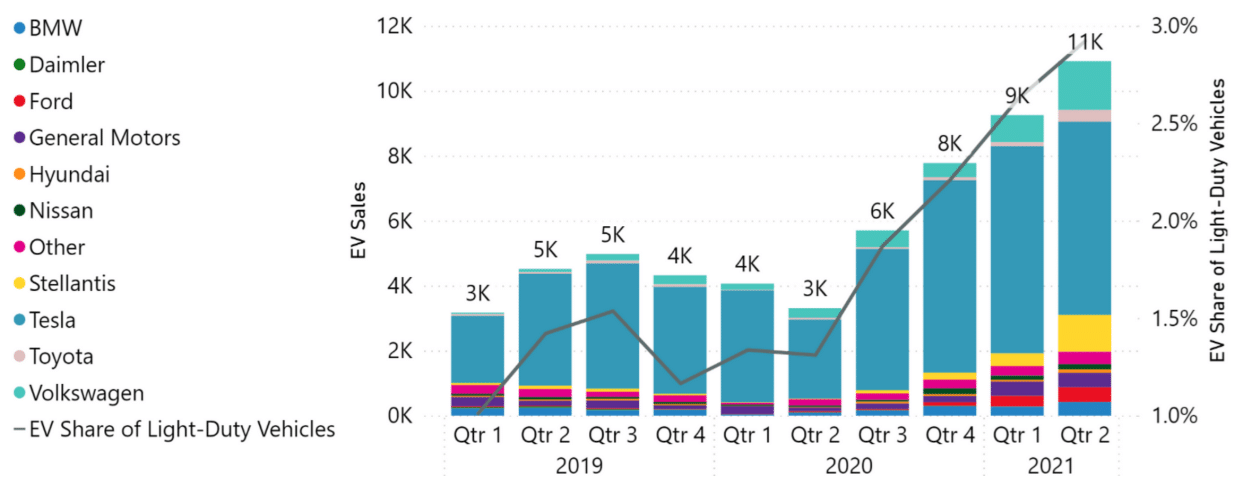In the summer of 2020, Florida Governor DeSantis signed Section 339.287, FS, into law requiring the Florida Department of Transportation (FDOT) to coordinate, develop, and recommend a plan to develop electric vehicle charging station infrastructure along Florida’s highways. The Florida EV Master Plan that FDOT delivered to the Governor is a comprehensive examination of the light-duty passenger EV charging infrastructure landscape, including recommendations for supporting and expanding electric car, truck, and bus adoption.
The EV Master Plan is applaudable
FDOT did a commendable job highlighting EV adoption benefits, trends, barriers, and considerations across multiple vehicle types and use cases. Many of the objectives and strategies outlined in the plan will support Florida EV market growth:
- Adapt transportation infrastructure to advance electrified mobility, including removing barriers to widespread charging station deployment, filling in EV charging gaps to enable travel throughout the state, and supporting municipal and local agencies charging infrastructure needs.
- Facilitate the transition of next-generation infrastructure, including unlocking state funding for charging infrastructure deployment focusing on low-income and historically disadvantaged communities, ensuring changing stations adhere to open-source data and interoperability standards, and developing minimum EV-ready parking requirements.
- Enhance education and outreach efforts, including launching consumer and fleet-oriented education and outreach programs, training Florida’s workforce, especially from underserved communities, to service EVs, and install, service, and maintain charging infrastructure, and developing guidance on charging infrastructure and equity considerations in long-range transportation plans
- Engage other stakeholders on EV infrastructure deployment, including partnering with other states in the Southeast to harmonize interstate corridor electrification efforts, evaluating the benefits and impacts of incorporating charging infrastructure into the electricity grid, and engaging federal, state, local, private, and research organizations with diverse representation from low-income and historically disadvantaged communities.
The Plan is also lacking
During FDOT’s review, some of the EV Master Plan recommendations in early plan drafts were removed by the Governor’s office. These include impactful actions presented by Florida Power & Light during Senate Transportation Committee testimony:
- Establish state-wide consumer and fleet EV adoption and charging station deployment goals. The ultimate goal of the EV master Plan is to support and expand consumer and fleet electrification. Measuring plan success requires metrics to measure against.
- Consider adopting a zero-emission vehicle (ZEV) standard. Twelve states representing nearly 40% of the new car market have adopted ZEV standards, while others are considering “low carbon fuel standards.” Because automakers prioritize selling EVs in states that adopt such policies, states that do not may struggle to get limited inventory onto showroom floors.
- Develop recommendations and strategies to guide utility charging infrastructure investment. The challenge is not determining if utilities need to invest but rather how to optimize investments to be appropriate within the regulatory framework and supportive of the urgent charging station deployment, technology innovations, and resilience needs to support EV market growth.
- Affirm the Public Service Commission’s authority to approve innovative rate structures. Rate structures supporting EV charging deployment and operation, incentivizing private market investment, and delivering maximum electricity grid benefits are critical to ensure EV adoption leads to downward pressure on electric utility rates for all utility customers.
Planning is needed because the market is accelerating
Florida’s completion of the EV Master Plan is a critical step as the state’s EV market is poised to expand rapidly. We at the Southern Alliance for Clean Energy (SACE) and Atlas Public Policy track the EV market across the Southeast and publish an annual “Transportation Electrification in the Southeast” annual report. The report includes a snapshot of Florida’s EV market activity, highlighting and comparing the state to others in the region. What we found is that Florida leads the region across key indicators.
Florida’s EV Market Indicators through July 2021

Automakers are investing heavily to ramp up EV production. There are 71 EV models available today. Many automakers, including General Motors, Ford, Honda, Hyundai, and Volkswagen, have committed to ending the production of gas cars and trucks, shifting their product lines to 100% EVs.
This industry momentum is visible in Florida’s EV sales data that shows various automakers beginning to chip away at Tesla’s dominance as EV sales across the state quickly approach the 3% market penetration milestone.
Florida EV Sales Since 2019

Florida has a lot riding on successful EV Master Plan implementation
The EV Master Plan identifies key objectives and strategies to help move the market. The plan needs to be implemented effectively, requiring direct state and utility investment and leveraging existing and anticipated federal funding. Doing so will help accelerate car, truck, and bus electrification that, in turn, will save Floridians a boatload of cash.
SACE recently published “Retained Transportation Fuel Spending in the Southeast: Electric vs. Internal Combustion Vehicles.” The report shows that electrifying transportation will save consumers money at the plug and keep more of their transportation fuel dollars recirculating through local economies.
Take Florida, for example. The state spends $ 27.6 billion annually importing gas and diesel. EVs can do the same work for $17.2 billion, saving consumers and fleet operators $10.4 billion annually.
Additionally, of the $27.6 billion spent annually at the pump on gas and diesel fuel by consumers in Florida, SACE estimates that only $9.65 billion, or a little over one-third, of those expenditures, are retained in Florida. The rest leaks out of the state’s economy.
Expenditures Retained In-State vs. Leaving State, by Fuel (Billion $, 2019)

If consumers and fleet operators were using electricity to power transportation, they would spend less on fuel plus over two-thirds of the money spent to power EVs would stay in the state’s economy. Adding this all up, SACE found that if all the cars, trucks, and buses in Florida were electric today, there would have an extra $12.5 billion circulating annually through Florida’s economy.
SACE and our fellow electric transportation advocates stand ready to help FDOT and the state implement a successful plan that achieves the highest level of light, medium, and heavy-duty EV penetration possible. There is a lot of work to do, including implementing supportive policies and utility regulations, engaging in consumer and fleet outreach and education, and ensuring outcomes benefit all Floridians equitably. With new federal funding to electrify the nation’s fleet becoming available, automakers aggressively bringing longer-range and lower-cost EVs to market, and Florida’s utilities ramping up engagement, the stage is set for success.
Electrify the South is a Southern Alliance for Clean Energy program that leverages research, advocacy, and outreach to promote renewable energy and accelerate the equitable transition to electric transportation throughout the Southeast. Visit ElectrifytheSouth.org to learn more and connect with us.




